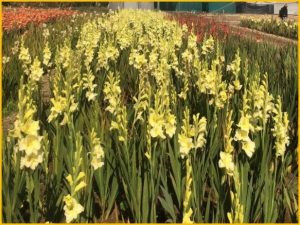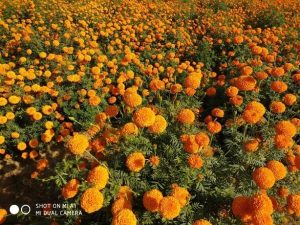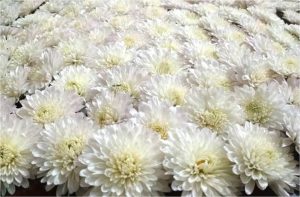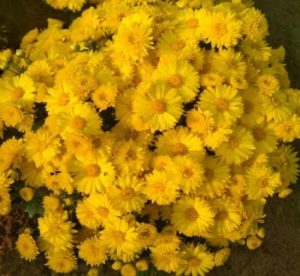(A) VARIETIES DEVELOPED:
Gladiolus:
- Punjab Glad-3 (2019)
- Punjab Glad-2 (2016)
- Punjab Glad-1(2013)
- Punjab Pink Elegance (2010)
- Punjab Flame (2010)
- Punjab Glance (2010)
- Punjab Lemon Delight (2010)
Marigold:
- Punjab Gainda No.1 (2016)
Chrysanthemum:
- Punjab Shingar (2018)
- Punjab Mohini (2018)
- Punjab Shyamli (2015)
- Anmol (2007)
- Royal Purple (2007)
- Yellow Delight (2007)
- Autumn Joy (2007)
- Garden Beauty (2007)
- Winter Queen (2007)
Annual Chrysanthemum:
- Punjab Bahar Guldaudi 1
- Punjab Bahar Guldaudi 2
Antirrhinum:
- Punjab Antirrhinum -1 (2021)
- Punjab Antirrhinum – 2 (2021)
- Punjab Antirrhinum – 3 (2021)
- Punjab Antirrhinum – 4 (2021)
Pansy:
- Punjab Sunaina (2017)
- Punjab Neelma (2017)
- Punjab Purple-Wave (2013)
- Punjab Choco-Gold (2013)
Sweet Pea:
- Punjab Sweet Pea-1 (2016)
- Punjab Sweet Pea-2 (2016)
- Punjab Sweet Pea-3 (2016)
- Punjab Sweet Pea-4 (2016)
- Punjab Sweet Pea-5 (2016)
VARIETIES RECOMMNEDED:
Tuberose:
- Arka Prajwal
(B) RECOMMENDATIONS ON PRODUCTION TECHNOLOGY
Chrysanthemum: Propagation of standard varieties (2022)
- The cuttings of standard chrysanthemums dipped in the solutions of IBA @ 400 ppm or NAA @ 200 ppm and planted in burnt rice husk media improved the rooting ability and showed 95 percent survival, one month after transplanting in pots.
Weed Control in Marigold: (2021)
- Application of paddy straw mulch @ 4 t/acre and silver-black polythene mulch of 25 micron reduced the weed density and dry weed biomass both during summer and rainy season in marigold. Number of flowers per plant also increased during both the seasons.
Orchid (Dendrobilrm spp.) -A new crop for cultivation in Punjab (2020)
- Technology for high-tech polyhouse cultivation of Orchid (Dendrobium sp.) cv. Sonia Red in perforated pots with coco hulls, charcoal and vermicompost in l: l: l ratio as the potting media in Punjab conditions.
Gladiolus: Early flower production (2018)
- First week of July to third week of August is the most suitable time for planting of gladiolus varieties ‘Punjab Glance’ and ‘Punjab Lemon Delight’ for early flower production.
Fertigation schedule for Marigold (2018):
- Drip irrigation at 100 % Etc along with fertigation of 100 Kg N/ha (220 Kg urea per ha) resulted in 20.6 % increase in flower yield.
Boston Fern (2017):
1. Shade level: 75%
2. Planting distance: 45 x 30 cm
3. Nutrition: FYM at 25 t/ha along with N at125 Kg/ha in 4 equal splits at 3 months
interval
Weed control (2007):
- Coreopsis lanceolata: Stomp @650ml/acre +Two hand weeding
- Helichrysum bracteatum: Stomp@ 650ml/acre +Two hand weeding
- Helichrysum bracteatum: Treflan @ 625 ml/acre +Two hand weeding
Planting time (2005):
- Coreopsis lanceolata: First week of November
- Phlox drumondii : First week of November
- Helichrysum bracteatum : First week of November
- Gaillardia aristata : Third week of November
- Coreopsis tinctoria: Third week of November
Plant spacing (2005):
- Coreopsis lanceolata :60 x 40 cm
- Coreopsis tinctoria : 60 x 40 cm
- Gaillardia aristata: 60 x 40 cm
- Helichrysum bracteatum: 60 x 40 cm
- Phlox drumondii : 30 x 30 cm
(C) RECOMMENDATIONS ON POST HARVEST TECHNOLOGIES:
Packaging and Storage of Annual Chrysanthemum flowers (2021):
- Packing annual chrysanthemum flowers in CFB boxes (3ply) for storage and transportation can extend the postharvest life for 2 days without any loss in flower quality.
Use of corrugated fiberboard (CFB) boxes for postharvest handling of marigold flowers ( 2020):
- Use of CFB boxes (3ply) for storage and transportation can extend the post harvest life of marigold flowers for 3 days over their shelf life without any loss in flower quality.
Value addition of Tuberose spikes through tinting ( 2020)
- The spikes of tuberose can be tinted by dipping basal portion (5-7cm) in dye solution having 1% food dye of desired colour, 2% sucrose and 300 mg/l citric acid for 2 hrs.
Recommendation on modified atmospheric packaging and storage of gladiolus spike (2019):
- Ten spikes of gladiolus harvested at tight bud stage (basal 1-2 florets show colour) and packed in Polypropylene sleeve (PP 100 gauge having 120 cm length, 18 cm width having 50 perforations) could be stored vertically in cold room (5± 0.5 ° C) for 10 days with acceptable flower quality and vase life upto 13 days.
Recommendation on flower drying (2017):
- The flowers of Gomphrena/ panicles of Golden rod/ peduncles of Golden Rain Tree can be dried best by hanging in inverted position in well ventilated dark room for 4-5days and can be used upto 6 months.
Recommendation on foliage drying (2017):
- Fern: Dehydrated by dipping in 20% glycerine in well ventilated dark room for 7-8 days and can be stored for more than 6 months
- Silver Oak: Dehydrated by dipping in 20% glycerine in well ventilated dark room for 7-8 days and can be stored for more than 6 months
- Asparagus: Dehydrated by dipping in 20% glycerine in well ventilated dark room for 7-8 days and can be stored for more than 6 months
Recommendation on flower drying (2005):
- Laguras : Air-drying in inverted position
- Bromus: Air-drying in inverted position
- Statice : Air-drying in inverted position
- Briza: Air-drying in inverted position
- Larkspar : Silica gel embedding
|





